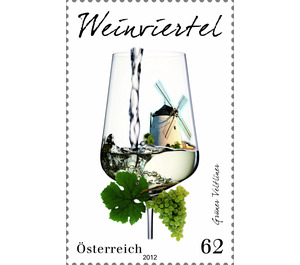wine regions - Austria / II. Republic of Austria 2012 - 62 Euro Cent
Theme: Cuisine & Groceries
| Country | Austria / II. Republic of Austria |
| Issue Date | 2012 |
| Face Value | 62.00 |
| Edition Issued | 812,000 |
| Printing Type | offset |
| Stamp Type | Commemorative |
| Item Type | Stamp |
| Chronological Issue Number | 2369 |
| Chronological Chapter | OOS-OE2 |
| SID | 721102 |
| In 54 Wishlists | |
The present stamp starts a new series of stamps, which deals with a particularly "precious" topic, the wine regions of Austria. It starts with the largest Austrian wine-growing region, the Lower Austrian Weinviertel. The boundaries of the Weinviertel run in the east along the state border from Austria to Slovakia, which is formed by the March. In the north, the Weinviertel borders the Czech Republic, where essentially the Thaya forms the natural border. The Manhartsberg, which lies to the east of the Kamps, represents the border to the Waldviertel in the west. In the south, the Weinviertel borders the Most and the Industrieviertel, where the Wagram, the Danube and the Marchfeld form the geographical border. Politically, the Weinviertel is divided into the districts Gänserndorf, Hollabrunn, Korneuburg and Mistelbach. Also the judicial district Kirchberg at the Wagram of the district Tulln as well as small parts of the districts horn, Krems country and Vienna environment lie in this region. Of particular importance in the Weinviertel - nomen est omen - viticulture. The cultivation area has a total area of nearly 16,000 hectares, the largest locations are the Retzer and the Falkensteiner vineyards, Poysdorf, the Matzner hill country, the Wolkersdorfer Hochleithen, Hagenbrunn and the Bisamberg. Two key factors are responsible for the ideal conditions of viticulture in the region. First, the Pannonian climate with its cold winters and hot, dry summers - for example, in Poysdorf, the sunshine duration is almost 2000 hours a year. The second indicator is the loess soils, ideal for the growth of the grapevines and grapes. By far the largest distribution of all cultivated grape varieties in the Weinviertel has the Grüner Veltliner, other varieties such as Pinot Blanc, Welschriesling, Zweigelt and Blauer Portugieser play a relatively insignificant role. Typical of the Grüner Veltliner are the intense bouquet and its freshness. Certainly, the description of the wine is often lyrical, but it is clear that a variety of flavors - from white pepper to tobacco - can be identified. Impressive to good Veltliners are the intense nose and the slender taste of citrus and peach. Contrary to popular belief, which is based on many rather temperate Veltliners, high-quality wines of this grape variety are quite storable. At tastings of older Grüner Veltliner impress again and again by their amazing freshness. New is the so-called "Weinviertel-DAC", an area typical Grüner Veltliner, which is recognizable by its light to green yellow color and the spicy-fruity taste. The wines are dry and their alcohol content is at least 12 vol%.


